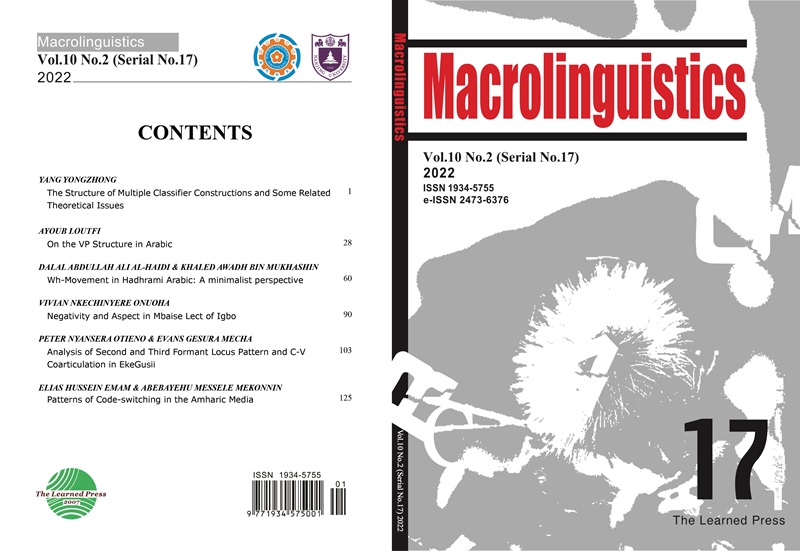Reflexivization and Reciprocality in the Kalabari Language
引用次数: 0
Abstract
This paper examines reflexivization and reciprocality in Kalabari with particular attention to the forms, functions and structures of reflexive and reciprocal constructions (the nominal sub-type) in the language. The paper adopts the binding theory as a framework in analysing the data. The data were gathered through interaction and introspection. The findings reveal that reflexives and reciprocals in Kalabari require a compatible clause-mate antecedent due to the strong anaphoric relationship between reflexive and reciprocal markers and their antecedents respectively. The findings further reveal that the form of Kalabari reflexives consists of -ḇù (-self) and the appropriate form of the pronoun in the language. The paper also reveals that the Kalabari language makes a tripartite distinction for number, person and gender, and the form of the reflexive does not change; only the pronoun changes, while reciprocals consist of a reduplicated form jụmọ jụmọ, jápụ jápụ and jéin jéin. In terms of the structure, findings reveal that reflexives and reciprocals come before the verb of the clause in which they occur. The finding further reveals that reflexives in the language perform both non-emphatic and emphatic functions, while reciprocal relates to human and non-human reference of mutuality. Tonal inflection also makes a distinction in 1st person singular and 2nd person singular reflexives. It is therefore recommended that more studies be done to ascertain the form, function and structure of the verbal and possessive sub-type of reflexive and reciprocal constructions in the language.卡拉巴里语中的反身性与互动性
本文考察了卡拉巴里语中的反身性和互惠性,特别关注了卡拉巴里语中反身性和互惠结构(名义子类型)的形式、功能和结构。本文采用绑定理论作为数据分析的框架。数据是通过互动和自省收集的。研究结果表明,卡拉巴里语中的自反和互反标记与其先行词之间存在强烈的回指关系,因此需要一个兼容的子句伴侣先行词。研究结果进一步揭示了卡拉巴里反身代词的形式由-ḇù (-self)和代词在语言中的适当形式组成。卡拉巴里语对数、人称、性别进行了三位一体的区分,反身句的形式没有发生变化;只有代词变了,而对等语则由重复的形式jụmọ jụmọ, jápụ jápụ和jsamin jsamin组成。在结构方面,研究结果显示反身句和往复句出现在它们所在的从句的动词之前。这一发现进一步揭示了语言中的反身反语具有非强调和强调两种功能,而反身反语则涉及到人类和非人类的相互指称。音调的变化在第一人称单数和第二人称单数反身代词中也有区别。因此,建议进行更多的研究,以确定语言中反身和对等结构的动词性和所有格子类型的形式、功能和结构。
本文章由计算机程序翻译,如有差异,请以英文原文为准。
求助全文
约1分钟内获得全文
求助全文
来源期刊
自引率
0.00%
发文量
83
审稿时长
20 weeks
期刊介绍:
Macrolinguistics (ISSN 1934-5755, e-ISSN 2473-6376) is an international academic journal which is specialized in research papers of non-Indo-European linguistics. It is published biannually by The Learned Press and funded by the Double First-Class Initiative of Nanjing University. It aims at contributing to the complementarity and interaction of linguistic research worldwide.

 求助内容:
求助内容: 应助结果提醒方式:
应助结果提醒方式:


